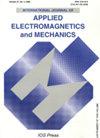Numerical simulation of aircraft lightning attachment zone using the enclosing ball method
IF 1.1
4区 工程技术
Q4 ENGINEERING, ELECTRICAL & ELECTRONIC
International Journal of Applied Electromagnetics and Mechanics
Pub Date : 2024-03-12
DOI:10.3233/jae-230026
引用次数: 0
Abstract
The initial stage in aircraft lightning protection design and safety certification involves delineating the lightning attachment zone. The lightning leader’s development is inherently random, favoring the shortest path to the aircraft fuselage. In response, we employ the enclosing ball method to establish the lightning attachment zone. First, define the center point of the aircraft as the coordinate position for the sphere’s center, creating a sphere with a specified radius. The leader’s initial position is then selected from any point on the sphere. Second, by calculating distances between the leader’s position and various areas on the aircraft surface, we determine the shortest path. The corresponding aircraft surface area along this path is identified as the lightning attachment zone for the leader. Subsequently, choose a new leading position on the sphere and iterate through the calculation process until all sphere positions are considered. Finally, tally the occurrence frequencies for all calculated attachment areas, representing the attachment probability of each area based on its frequency of occurrence. This paper not only compares our method with the electrostatic field simulation method but also contrasts it with the probability distribution of lightning attachment points obtained from aircraft flight experiments. The comparison results are highly favorable, providing robust verification for the correctness of our approach.使用包围球法对飞机雷电附着区进行数值模拟
飞机雷电防护设计和安全认证的初始阶段包括划定雷电附着区。雷电引线的发展具有固有的随机性,偏向于以最短路径到达飞机机身。为此,我们采用了包围球的方法来确定雷电附着区。首先,将飞机的中心点定义为球体中心的坐标位置,创建一个具有指定半径的球体。然后从球体上的任意一点选择领航员的初始位置。其次,通过计算领航员位置与飞机表面各区域之间的距离,我们确定了最短路径。这条路径上相应的飞机表面区域被确定为领航员的闪电附着区。随后,在球面上选择一个新的引导位置,并重复计算过程,直到所有球面位置都被考虑在内。最后,统计所有计算出的附着区域的发生频率,根据发生频率表示每个区域的附着概率。本文不仅将我们的方法与静电场模拟方法进行了比较,还将其与飞机飞行实验中获得的雷电附着点概率分布进行了对比。对比结果非常理想,为我们方法的正确性提供了有力的验证。
本文章由计算机程序翻译,如有差异,请以英文原文为准。
求助全文
约1分钟内获得全文
求助全文
来源期刊
CiteScore
1.70
自引率
0.00%
发文量
100
审稿时长
4.6 months
期刊介绍:
The aim of the International Journal of Applied Electromagnetics and Mechanics is to contribute to intersciences coupling applied electromagnetics, mechanics and materials. The journal also intends to stimulate the further development of current technology in industry. The main subjects covered by the journal are:
Physics and mechanics of electromagnetic materials and devices
Computational electromagnetics in materials and devices
Applications of electromagnetic fields and materials
The three interrelated key subjects – electromagnetics, mechanics and materials - include the following aspects: electromagnetic NDE, electromagnetic machines and devices, electromagnetic materials and structures, electromagnetic fluids, magnetoelastic effects and magnetosolid mechanics, magnetic levitations, electromagnetic propulsion, bioelectromagnetics, and inverse problems in electromagnetics.
The editorial policy is to combine information and experience from both the latest high technology fields and as well as the well-established technologies within applied electromagnetics.

 求助内容:
求助内容: 应助结果提醒方式:
应助结果提醒方式:


